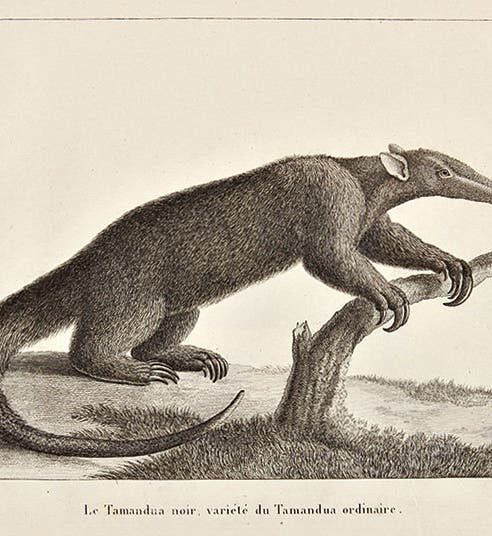Scientist of the Day - Félix de Azara
Félix de Azara, a Spanish military officer and naturalist, was born May 18, 1742. Azara was trained as a military engineer in Barcelona, and in 1781, he received a mysterious assignment to report to Lisbon and to board a ship for destination unknown; the destination turned out to be Montevideo, South America, and the assignment was to negotiate with the Portuguese to determine the exact border between Portuguese and Spanish holdings in South America. Unfortunately for Azara, the Portuguese had no interest whatsoever in negotiating a border and refused to meet, and had Azara stuck to military engineering, he would have twiddled his thumbs for 20 years, for his superiors did not bring him back to Spain until 1801. Fortunately, Azara was interested in birds and mammals, and even though he had no training in natural history, and no resources in the form of books or colleagues, he set out to study the fauna of Paraguay. He wrote descriptions of scores of mammals and hundreds of birds, most of which had not been studied by any European. He was unusual in another way – he preferred to study his animals and birds while they were alive rather than filled with buckshot, so he filled his house with owls and monkeys and all manner of armadillos, many of which he was able to keep alive for astonishing lengths of time, considering that most wild animals do not take well to captivity. One of his adoptees was a tree porcupine, Coendou prehensilis, which looks something like this. Azara noted that it would not sit on a flat surface, but only on the back of a chair, until it discovered the top of the shutter just outside his window, after which, it would perch nowhere else. It would come down twice a day to eat fruit and twigs, and then retire to its shutter, and it would not move until overtaken by its next gastric pangs. When Azara put a dead mouse in its bowl one day, the porcupine was so nonplussed that it ran back to its perch and refused to eat for days. Not a very exciting life, but the point is, no one knew anything about tree porcupine behavior until Azara did his little set of domestic experiments. It wasn't until Azara was ordered to Buenos Aires in 1796 that he had the chance to see a real natural history reference work, in this case the comte de Buffon's Histoire naturelle, which been launched in 1749 and was approaching 40 volumes when Azara chanced upon it. It was considered the crowning achievement of the French natural history tradition, but Azara was appalled at how many mistakes there were – it was evident to Azara that Buffon had never even seen many of the animals that he was commenting upon. Azara set about writing his own natural history of Paraguay, first a pair of volumes about quadrupeds, which was published in 1802 (but preceded in 1801 by a pirated French translation), and this was followed by three volumes on birds (paxaros) from 1802-05. In these works, Azara was not at all shy about voicing his criticism of Buffon. But for reasons not clear to me, few of the next generation of naturalists read these Spanish editions. Azara was mostly known through an 1809 French edition of his travels, called Voyages dans l'Amerique meridionale, which he authorized when he was in Paris after his return, but which he was unable to supervise after he went back to Barcelona. His Parisian editor, a great partisan of Buffon, removed most of Azara's critical comments and drastically pruned much of the text as well. The result was a poor rendition of Azara’s impressive accomplishments in natural history. Nevertheless, two subsequent travelers to South America were much impressed by Azara. Alcide d'Orbigny, a French naturalist who went to South American in 1826, commented that he read Azara's Voyages beforehand, and he found him to be unfailingly accurate, especially in his description of animal habits, much more so than any other naturalist writing about South America. Another reader, somewhat better known than d'Orbigny, was Charles Darwin. He too read the Voyages shortly after he returned from his own trip on the Beagle, and when he wrote up his Journal of Researches (1839) and his Zoology of the Beagle (1839-42), he constantly praised the accuracy of the "highly regarded" Azara. We do not have any of Azara's works in our Library. The Spanish first editions, Apuntamientos para la historia natural de los quadrupedos del Paraguay (1802) and Apuntamientos para la historia natural de los paxaros del Paraguay (1802-5) seem to be unobtainable. The 1809 Voyages comes on the market now and then, but usually at a high price; if Darwin had just kept that "highly regarded" comment to himself, the asking price would be half what it tends to be, and just about right. There is one very nice copy on the market right now, from which we borrowed the engraving of a tamandua (first image); you can see on the dealer’s webpage an additional jaguar plate, as well as a photo of the four text volumes standing upon the atlas of 25 maps and plates.
There survives only one portrait of Azara, executed by the renowned Francisco Goya in 1805; it is now in the Museo Camón Aznar in Zaragoza (second image). It demonstrates, as much as anything, that 20 years spent by oneself in the outback of the Rio de la Plata does not teach one how to properly pose for a great master. Somewhat more pleasing, perhaps because it lacks the toucan-tinted trousers, is a statue based on the Goya painting that sits outside the Museu Martorell in Barcelona. Dr. William B. Ashworth, Jr., Consultant for the History of Science, Linda Hall Library and Associate Professor emeritus, Department of History, University of Missouri-Kansas City. Comments or corrections are welcome; please direct to ashworthw@umkc.edu.







